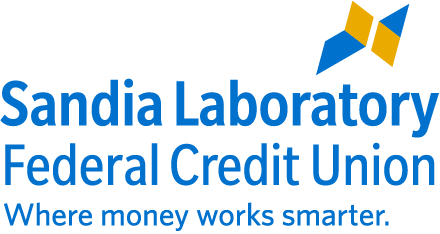The Home Buying Process
10 Steps to a New Home
Purchasing a home can be daunting. Even if you’ve done it before, things change over time – the real estate market, the financing process, and your family’s needs. Following are the major steps of finding and financing a home for the average homebuyer, including recommendations and resources from Sandia Laboratory Federal Credit Union to help make your home buying process smoother.
STEP 1: TALK TO US.
You can talk to an SLFCU loan officer at any point during your home buying process, although we strongly encourage all first-time homebuyers to connect with us as early as possible. We can walk you through the major steps of buying a home and provide resources to help you search for a real estate agent and the right home. We can also answer any questions and concerns you might have, including what you can afford, how much you should save, how long the process usually takes, and how to maintain or improve your credit score.

STEP 2: SAVE FOR YOUR HOME BUYING COSTS.
There are three things you need to save for when you’re planning to buy a home: a down payment, closing costs, and initial property tax and insurance costs. An SLFCU mortgage loan officer can give you an idea of the total amount you should save.
-
Down Payment: At SLFCU, the down payment for first-time homebuyers can be as little as 3% of the purchase price of a home. The minimum down payment for those who have purchased a home before is as low as 5%. Down payments can come from savings or gifts from eligible donors.
-
Closing Costs: Closing costs are fees paid when purchasing a home. When you buy a home, you will typically pay some mortgage-related fees, and the seller will pay others. Many of these fees can be negotiated when you make an offer (your real estate agent can help you with that), but you will generally have to pay some closing costs.
-
Property Taxes and Insurance: An escrow account is established by SLFCU on your behalf to hold funds for your property taxes and insurance. Your monthly payment will include about 1/12th of your estimated annual tax and insurance bills, and these amounts are held in your escrow account. When these bills are due, SLFCU pays them with the funds in that account.
Because you must be covered by homeowner’s insurance when you take ownership of your new home, you need to pay your entire first year of homeowner’s insurance upfront. In addition, you will need to make an initial escrow deposit at closing.

STEP 3: REVIEW YOUR CREDIT REPORT.
You can get a free copy of your credit report from each of the three major credit bureaus (Experian, TransUnion, and Equifax) once a year at annualcreditreport.com. Review your report and look for errors or inaccuracies you may need to address. Feel free to bring your report to SLFCU and ask a loan officer to review it with you.
If you carry a lot of debt, tend to pay bills late, or don’t have a long credit history, you may need to improve your credit by paying down your balances and changing your payment habits. Learn about the things that impact your credit score and how to improve in each category.

STEP 4: GET PRE-APPROVED FOR A HOME LOAN.
Getting pre-approved for a home loan before you start shopping can help you in two ways. First, you’ll know exactly what you can afford. You can give your real estate agent that number, and he or she can target your search for homes within your price range.
Second, you usually need to submit a pre-approval letter when you are making an offer on a home. This makes your offer stronger, as the seller will know that you have approved financing from a trusted lender.
You can start the application process for an SLFCU home loan online, by phone, or in person by visiting our Mortgage Center at our Jefferson branch.

STEP 5: SELECT A REAL ESTATE AGENT AND START SHOPPING FOR YOUR NEW HOUSE.
A real estate agent helps home buyers by educating them about the market, homes, and neighborhoods. They also help negotiate offers on homes, and once you submit a contract on a home you intend to buy, your agent can help you meet all of the necessary deadlines in that contract.
When you’re looking for an agent, consider:
- Communication skills and style. Make sure the agent explains things to your satisfaction and communicates via your preferred methods (email, phone, text message, etc.).
- Market and product knowledge. Your agent should be knowledgeable about the market and homes in the cities or neighborhoods where you are most interested in living.
- Accountability, integrity, and honesty. Your real estate agent works for you, and you should always feel comfortable with your home search and the decisions you are making.
When looking at houses with your real estate agent, it’s helpful to think about the things you need versus the things that you want, and then prioritize the items in each category. There’s no such thing as a perfect house, and you’ll likely need to compromise on your needs and wants. For example, if a good school district is very important to you, you may have to compromise on the size of the home you can buy since the homes in top school districts tend to be higher priced.
STEP 6: MAKE AN OFFER, NEGOTIATE IT, AND FINALIZE THE CONTRACT OR PURCHASE AGREEMENT.
Once you’ve found a home you would like to purchase, your real estate agent will work with you to put together an offer. This offer includes the amount you’re willing to pay, who you think should pay which closing costs, supporting documents such as your preapproval letter, and your earnest money.
Earnest money is like a security deposit on a home you hope to buy – usually $1,000. Earnest money shows the seller that you are serious about buying the home, and it is held in escrow by the title company until closing, where it’s credited toward your down payment.
After you submit your offer, there will likely be additional negotiations between you and your real estate agent and the home seller and his or her agent to agree on the price of the home and who will pay which closing costs. After all parties accept an offer, you are considered “under contract” to purchase that home.
Once you and the seller reach an agreement, the contract/purchase agreement will be signed. You will need to provide a signed copy of that contract/purchase agreement to your loan officer, receive your loan disclosures, and provide an Intent to Proceed.
STEP 7: HAVE THE HOME INSPECTED AND APPRAISED.
The next step is to have the home inspected by a licensed home inspector. The inspector’s job is to examine the interior and exterior of the home as well as all mechanical elements and provide a report detailing the true condition of the home. You will select the home inspector and may also opt to pay for additional inspections for radon, mold, and more.
Depending on the home inspector’s findings, you may want to renegotiate your offer. You can ask the seller to repair or replace things as necessary or ask for a reduction in the purchase price of the home. Your real estate agent will help you with this process. SLFCU may require certain habitability items to be repaired prior to closing.
A licensed professional, chosen by SLFCU, will visit the home to generate an appraisal – an independent assessment of the home’s market value. If the appraised value of the home is lower than what you have agreed to pay, your real estate agent and loan officer will work with you to determine the best course of action, such as renegotiating the price or increasing your down payment.
STEP 8: ACQUIRE HOMEOWNERS (HAZARD) INSURANCE.
You are required to have homeowners insurance (sometimes called hazard insurance) on your home. You can get quotes from various insurance companies and choose the company and insurance you’d like to use. It's important to select the insurance company right away as to not delay the closing.
STEP 9: FINALIZE ADDENDUMS AND CONDUCT THE FINAL WALKTHROUGH.
Any changes to the purchase agreement or contract are called addendums, and they must be signed by all parties. This includes who will pay which costs, what repairs still need to be addressed, and any changes to the final closing date. All addendums must be given to the lender as soon as possible because these addendums complete the purchase agreement.
You’ll also schedule a walkthrough of your home before you sign the final paperwork so that you can ensure the home is in the condition you expect. This might include confirming whether requested repair work has been completed satisfactorily or that the seller hasn’t made any unexpected modifications to the home.

STEP 10: CLOSE YOUR LOAN AT THE TITLE COMPANY AND MOVE INTO YOUR NEW HOME.
“Closing your loan” means signing the final paperwork. Home loans are usually closed at the title company. A title company ensures legitimate ownership of a property, ensuring that there are no issues with the title to your home – like unpaid mortgages or taxes, liens, etc. The title company also issues title insurance, which is required and protects you and your lender in case there are any future legal claims on your home.
At closing, the title company will explain all of the documents that you will be signing and will give you copies of all paperwork.
After the money has been distributed to the appropriate people or agencies and documents have been recorded, you’ll receive keys from the title company and move into your new home!





